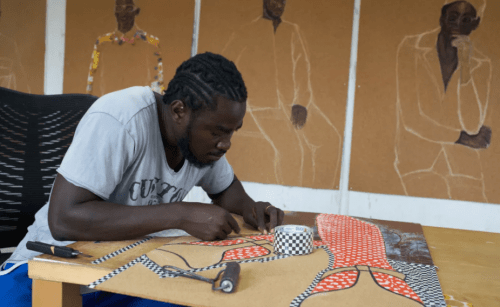
Portrait of Ghanaian
(Image credit: Serge Attukwei Clottey)
Serge Attukwei Clottey on fashion, gender, and unexpected art
In captivating new portraits for ‘Beyond Skin’, Ghanaian artist Serge Attukwei Clottey explores fashion as identity and subverts antiquated ideas of gender and sexuality
BY PEI-RU KEH
LAST UPDATED OCTOBER 12, 2022
Ghanaian artist Serge Attukwei Clottey is hot off the back of Desert X in Palm Springs, where he staged a sculptural installation comprising yellow plastic jerry cans, used to transport water in Ghana. Now, he is presenting a new body of work in ‘Beyond Skin’, a solo show currently on view at Simchowitz Gallery, Los Angeles. The exhibition brings together ideas of image-making and identity construction – themes that Clottey has long explored.
Inspired by mid-century black and white photography originating from the coast of West Africa, Clottey’s works update the visual language of historical images and transports them into the present day.
Working with a wide array of materials, including duct tape, cork and collages made from posters in dressmaking shops, Clottey combines a dynamic energy with a variety of cultural influences. ‘The conversation starts with our histories and how we [Africans] have evolved in terms of how we present ourselves,’ explains Clottey. ‘I won’t say I’m juxtaposing the classical with the unexpected, but I’m throwing light on the evolution of image-making; who makes the image, and where are these images shown.’
Another memorable aspect of the portrait-based series is the use of fashion as a facet of identity. Vibrantly detailed and demonstrating a bold choice of colours that intentionally subvert conventional notions of gender and sexuality, Clottey’s subjects collectively celebrate individuality, while rebelling against antiquated notions of personhood.
‘I’m interested in finding everyday materials and using them in unconventional ways,’ says Clottey, who was a fashion model for a time. ‘The exploration of these materials sometimes gives them a whole different meaning and also starts conversations on the alternative uses of the material that people may not have thought of. I won’t say they are unexpected materials but rather, they help me create unexpected artworks.’
He continues, ‘I’m always looking at how materials can significantly influence a work, and how it fits in the ideas I explore to create a shared understanding. I’ve always been inspired by alternative fashion and styling; one that is created by the individuals who wear them, and the media they use in sharing these creations. So instead of using paint to design the dresses of the characters, I use a material, [like duct tape] that will let me cut and join materials like the designers, tailors and seamstresses do in their shops and fashion houses.’
The result is an uplifting array of work that recognises the past while reframing it for the present. Duct tape, a crude and at times violent tool, has been reclaimed as a symbol of strength and protection when tracing the body of Clottey’s subjects. His use of cork as a canvas also alludes to the use of notice boards back in his hometown as a means of communication and conveyance.
Steeped in meaning, while still charged with visual energy, the works invite viewers to delve beneath the surface.